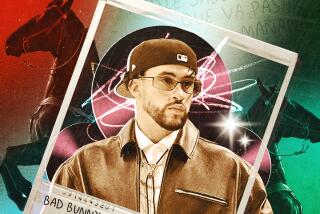Review: Raiford Rogers’ latest moving pictures lift off from the dance stage
The choicest seats for viewing Raiford Rogers Modern Ballet are in the back, just far enough from the stage to view all the dancers at once, without having to do that back-and-forth, tennis-head motion. What Rogers does so unusually well, sometimes extraordinarily, is to paint the stage with moving pictures, and it’s so much easier to appreciate the images he’s creating when you can take them in all at once, whole and complete.
This was especially so with “Naiveté of Flowers,” a celebratory work of colorful dynamics and bubbling energy that had its premiere Saturday at the Luckman Fine Arts Complex at Cal State L.A. In a twist, Rogers chose music he’s used before, recorded selections from the Lloyd Rodgers’ score for the 1986 full-length ballet “The Little Prince,” made for the long-gone but beloved Los Angeles Chamber Ballet.
The composer, who died two years ago, made music with several L.A. choreographers, including Rudy Perez. Rodgers experimented with various styles but came to be known primarily as an early post-minimalist. This is the fourth piece Rogers has made to the composer’s music, and the evening was dedicated to him.
The lush score, filled with evenly spaced blips and beeps, felt cheerful, and dancers depicted this with plentiful peppiness. The choreography accented the music’s straightforward beats, so the 13 performers whirled and lifted off into leaps with a sense of freedom, the music seeming to push them forward and upward. Dancers bent backward and then forward, like grasses or flowers blowing in the wind. Another particular pose reminded me of a child pretending to be an airplane.
But Rogers is not telling a story; rather he is filling the entire stage with imagery from the floor to the top of the proscenium. The backdrop for “Naiveté” was a series of continuously shifting photographs of drip paintings by artist Mike Nava. The white blotches gave way to yellows, then blues, then reds. The ballet’s third movement was an unpretentious all-female trio, and Rogers spaced the performers in a wide triangle so that the dancing encompassed the shifting backdrop as an active part of the scene.
Lighting designer John A. Garofalo crafted beautifully silhouetted beginnings for several movements. The dancers wore short, midnight blue (perhaps black) unitards that left an after-image that recalled the swirls from a calligraphy pen.
The program opened with Rogers’ 2017 “Joshua Tree Symphony,” the second piece he’s made to music by Czech composer Zbynek Mateju. “Joshua Tree Symphony” premiered last year, and on this second viewing, it was easier to pull out the logic and through-lines in Rogers’ choreography. It’s still a challenging, intense piece.
The music is something of a bear — wild and chaotic, with giant crescendos that stop without warning. Rogers attempts to tame the music and give shape to the ballet through unerring control and geometric poses. Couples enter separated by a few seconds, launching into repeated dance phrases. It gives the dance a layering quality that’s similar to the musical cacophony, but the dance appears more logical.
The backdrop, also by Nava, is another photo animation of thickly applied paintings in deep greens, reds and browns. Here, however, the visuals seem to stand apart from the ballet, perhaps because of the overpowering quality of Mateju’s symphony.
Rogers’ ballets are so difficult to perform, and his cast was outstanding — holding legs magisterially aloft, balancing like statues and repeating his purposely narrow vocabulary of steps without letting either energy or urgency falter. Special kudos to all the elegant soloists, including Tigran Sargsyan, Gustavo Barros, Chelsea Paige Johnston and Elizabeth Walker.
See all of our latest arts news and reviews at latimes.com/arts.
More to Read
The biggest entertainment stories
Get our big stories about Hollywood, film, television, music, arts, culture and more right in your inbox as soon as they publish.
You may occasionally receive promotional content from the Los Angeles Times.






